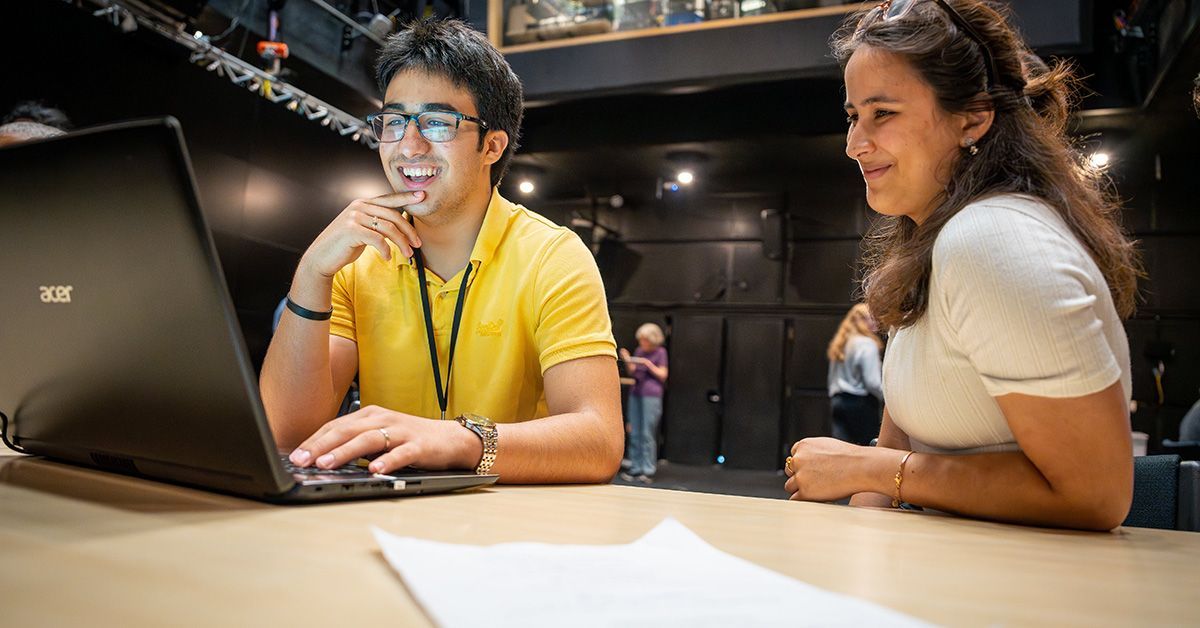Interns with UC San Diego NeuroDiversity in Tech Program Find Community at the Qualcomm Institute
Story by:
Published Date
Article Content
As a child, Isabel Merced Galindo felt “deeply disengaged” from science. Lectures felt removed and uninteresting to her. She couldn’t see how science was part of her life, and that made it easy to forget the facts she was supposed to memorize.
What she and her younger brothers did remember were games.
“[My brothers] had very little motivation to learn what they needed to,” Merced Galindo said. “So I thought, ‘What if we made it a game?’”
Now a rising college freshman, Merced Galindo has just finished a nine-week stint as an official game designer with the UC San Diego Qualcomm Institute’s (QI) NeuroDiversity in Tech internship program. The program creates opportunities for young adults on the autism spectrum to gain paid experience in video game development, while learning teamwork skills and industry-standard platforms for project management, communications, coding and software engineering. Its ultimate goal is to provide participants with the hard and soft skills to thrive in the tech field.
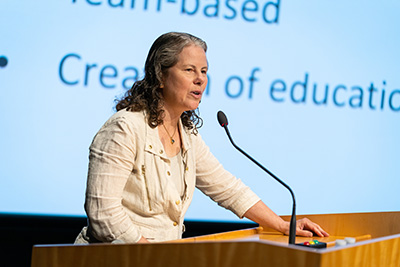
“What makes this internship unique is that you’re having fun creating an educational video game from the ground up, while also learning real skills with a great peer group,” said Professor Pamela Cosman, program director and a faculty member in Electrical and Computer Engineering with the UC San Diego Jacobs School of Engineering.
Programs like the NeuroDiversity in Tech internship are part of the Qualcomm Institute’s workforce development program, which seeks to prepare participants for careers in the growing technology industry. For autistic people, that investment can be particularly important.
This summer, the program hosted 15 interns, some of whom traveled from as far as the East Coast for the experience. In addition to the project work, interns heard industry representatives, including those on the autism spectrum, call in to offer insight and tips on securing positions in the field. Frequent lunch-and-learn sessions also helped participants learn and practice their public speaking and time management skills, and create or polish their LinkedIn accounts and resumés to increase their professional presence.
For Merced Galindo, who is adjusting to publicly identifying as autistic, the program’s focused but welcoming environment helped build an atmosphere of teamwork and understanding.
“I was able to trust others,” she said. “Now that I know what that’s like, and how efficient that is, I’m going to want that from other experiences.”
The Laws of Light
To provide real-world skills, the NeuroDiversity in Tech program connects participants with clients with project-based work. Working in teams with assigned roles, this year’s cohort coordinated with coaches, industry mentors and researchers from UC San Diego and the Massachusetts-based non-profit Concord Consortium.
Merced Galindo’s team partnered with Nicholas Antipa, an assistant professor with the Jacobs School’s Department of Electrical and Computer Engineering, to build a puzzle game based on light physics. Antipa’s lab specializes in computational imaging, a field that uses inventive hardware and software to create ever-more-powerful ways of imaging creatures, processes and places otherwise inaccessible to the human eye.
Seeking a tool to explain the basic principles behind his work, Antipa asked the team to design a video game appropriate for an eight-year-old audience. In addition to Merced Galindo, who was the group’s designer, the team included former NeuroDiversity in Tech intern Emmet Findlay, who acted as coach; Axis Familant, who assumed the role of artist; James Rackstraw, who acted as sound designer; and programmers Joshitha Muthukrishnan and Ronald Ji. The group settled on three levels that, by Antipa’s request, could be played in any order.
The game “Hue Hunt: A Lighthearted Quest” opens with a young child about to prepare for his school’s art contest. In a misguided attempt to help, the boy’s “mad scientist” father accidentally erases color from the world.
The player must undertake three separate missions to restore the world to its original state. Two of the three levels include animals, such as a Spanish-speaking frog that enlists players’ help to retrieve its lost sombrero from the bottom of a lake.
“English is almost always the default language in games. In a fantasy setting, I couldn’t see why we couldn’t have another language,” said Merced Galindo, who is of Puerto Rican and Mexican descent. “There’s not a lot of Spanish games or Spanish in games and I wanted future employers to know that is another type of representation I am passionate about.”
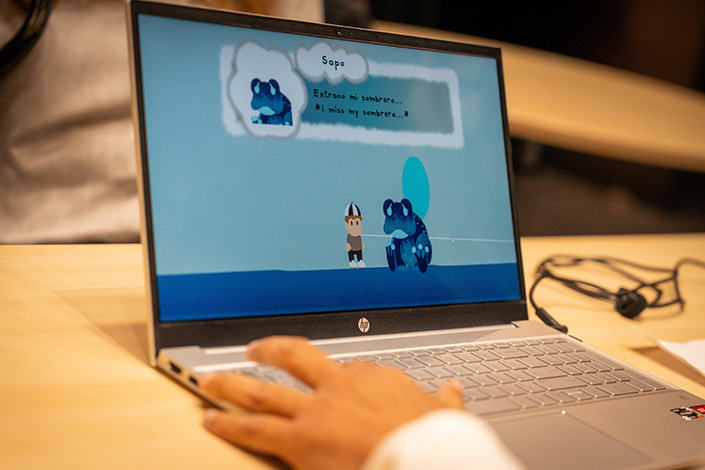
Using an in-game laser pointer, the player must take advantage of refraction—a phenomenon that changes the angle at which light passes from one medium, like air, to another—to lure a catfish to the frog’s sombrero then draw the catfish back to the surface. The game’s other levels demonstrate the principles of reflection and total internal reflection, in which light completely reflects back into its original medium.
“I was extremely impressed with the team’s initiative, creativity and follow-through,” said Antipa. “They were able to work from concepts and vague ideas, bringing them to life in ways I found truly inspiring.”
Exploring Bianca’s Lab
In approaching its game, the team behind “Bianca’s Lab” kept in mind the end goal of using their project as an outreach tool for children as young as five.
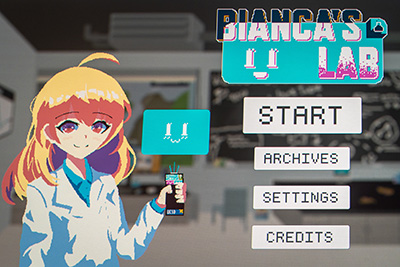
The team’s client, Alyssa Taylor of the Jacobs School’s Shu Chien-Gene Lay Department of Bioengineering, wanted to introduce children to bioengineering through a series of mini games. Led by project manager Jay Munger, the interns designed and coded several levels asking the player to clean a lab setting, work through a maze and match prostheses to a broken hip bone. A friendly bioengineer named Bianca and her robot assistant Gene provide encouragement and assistance.
To create a setting grounded in reality, Munger, designer Jack Griffith, artist Luna Martinez, sound designer Rackstraw, and programmers Sarah Scibelli and Derek Hidalgo took advantage of UC San Diego’s status as a premiere bioengineering site to visit Taylor’s lab and get a better sense of bioengineering. Throughout the creative process, they communicated closely with Taylor to ensure they met their client’s needs, while their team coach, Chris Fernando, a ’21 UC Irvine Computer Science graduate, helped them smooth over details.
Munger, a recent San Diego State University religious studies graduate, says at the outset the team experienced some challenges in managing their differing communication styles. By the third week, however, the group was running smoothly and individual members were showing their strengths.
“Project management is not unique to games or tech,” said Munger, who also did some script writing as part of the team. “I think that [skill set] definitely carries over regardless of where I end up.”
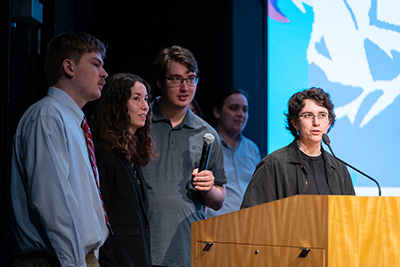
Munger expressed appreciation for the nature of the program.
“I haven’t seen many opportunities geared specifically toward autistic people and their particular interests or skill sets,” said Munger. “Other internships might not take into consideration the inherent communication differences or how people need to interact with their environment to stay comfortable. I think it’s important to have some place that is made for autistic people instead of just being retrofitted.”
Creating New Worlds
The NeuroDiversity in Tech program also opened space for creativity in meeting clients’ needs. The interns behind “ExpirAItion Date,” a mystery science fiction game, were tasked with developing a game in which players must interact with ChatGPT to learn clues and solve a mystery. Beyond that, their client, Lisa Hardy of the Concord Consortium, gave the group room to explore.
Teammates project manager Marcus Coleman, designer Rowan Fremont, programmers Erica Rice and Mariam Salem, and artist Jacob Walter brainstormed several storylines before settling on following a small team of scientists who accidentally time-travel to the 27th century. With the help of their holographic Generative Operational Support Tool, powered by ChatGPT, the player must solve logic puzzles to survive threats from the 27th century’s wildlife, repair their machine and return to the player’s own century.
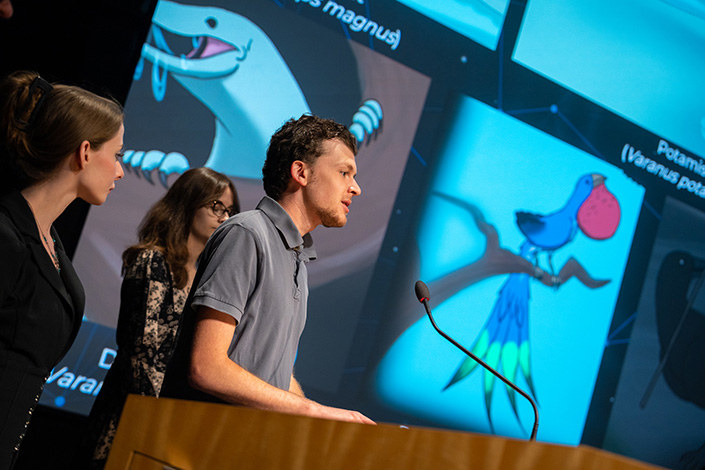
In creating their own, unique environment, the interns needed to train ChatGPT to respond to the player’s questions using their world’s knowledge base. Project manager Coleman familiarized himself with generative AI through LinkedIn Learning. Their coach, master’s student Omkar Bhope in UC San Diego’s Department of Computer Science and Engineering, aided them when they were stuck.
The game the group created mixes hand-drawn 2D art with 3D effects and generative AI. In building a post-civilization environment with realistic life forms, artist Walter, a rising sophomore in Biology and Art at the University of San Diego, had the chance to lean into a love of paleontology and speculative evolution: “It all comes down to making a world that feels more real in a sense, alive,” he said.
Although it was far from his first experience designing original characters, Walter said that being paid to do what he loved and fielding people’s questions about his work after the final presentations was validating.
“That lifted my spirits a lot,” he said. “The praise was definitely good for my confidence.”
The NeuroDiversity in Tech internship runs every summer at the Qualcomm Institute at UC San Diego. Applications open in February to any young adult seeking internship opportunities in video game development. For more information, see the Neurodiversity in Tech website.
Share This:
You May Also Like
Stay in the Know
Keep up with all the latest from UC San Diego. Subscribe to the newsletter today.
